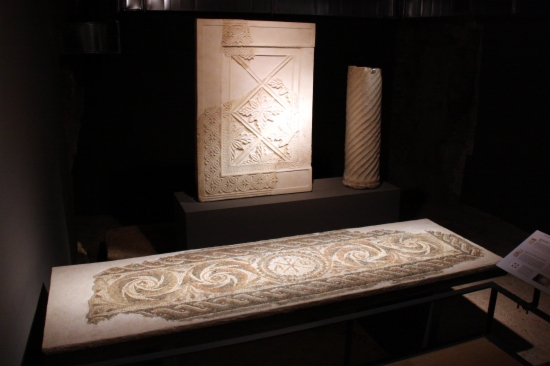Barcelona History Museum launches new exhibition on city's early Christian and Visigoth periods
This week, the Museum of the History of Barcelona (MUHBA) launched a new exhibition 'Barcelona in late antiquity: Christianity, Visigoths and the city'. 120 new pieces dating back from between the 4th and 7th centuries are going to be on display in the museum's Monumental Site of Plaça del Rei, in the heart of the Gothic Quarter. The launch has also been an opportunity to present the re-designed archaeological tour of this specific underground site, with its area which is open to the public growing in size. "The new archaeological discoveries contribute to explain the main transformations that took place in Barcelona, from Roman Barcino to Christianity", the curator Julia Beltran de Heredia said to CNA.

Barcelona (ACN).- On Monday, the Museum of the History of Barcelona (MUHBA) launched a new exhibition 'Barcelona in late antiquity: Christianity, Visigoths and the city'. 120 new pieces dating back from between the 4th and 7th centuries are going to be on display in the museum's Monumental Site of Plaça del Rei, in the heart of the Gothic Quarter. The launch has also been an opportunity to present the re-designed archaeological tour of this specific underground site, with its area which is open to the public growing in size comprising early Roman and early Christian ruins such as the reception room of the bishop and the baptistery. "The new discoveries contribute to explaining the main transformations which took place in Barcelona, from Roman Barcino to Christianity", the curator Julia Beltran de Heredia said to CNA.
MUHBA'S Monumental Site of Plaça del Rei covers an area stretching over 4,000m2, much of which is located underground, beneath the actual square. So far, a large part of it has not been open to the public. The aim of the project presented on Monday is to both show the new 120-piece collection and complete the existing archaeological tour by adding a new 310m2 space to the underground site. It represents the first step of a bigger project that will entail a re-designing of the Monumental Site of Plaça del Rei.
The exhibition curator stressed that a new area in the underground of the MUHBA museum will be open. This area will host the archaeological remains of two important buildings: the reception room of the bishop and the baptistery of the Episcopal group of Barcelona. The former being composed of three naves separated by columns built in the 5th century and used by the bishop as a reception room for hearings and the latter consisting of a 4th century baptismal font, square-shaped, and previously demolished in the 5th century.
The exhibition - located in this newly-open underground area of the museum - is going to shed light on the political, social, religious and urban transformations of Visigoth and Christian Barcelona. According to Beltran, the 120 new pieces includes "a wide range of objects such as paintings, marble plates, earrings, rings and coins". Moreover, she stressed that Visigoth Barcelona had an important role as demonstrated by the fact that the city hosted the Royal Court and two bishops. These conclusions represent the result of an 18-year-long research on Barcelona in late antiquity carried out by the museum services.
"Organising an exhibition in the MUHBA", she said "means to have limitations in terms of space. However, walking on floors dating back to the 4th and 7th centuries has the magic power of bringing the old city to life again".
Barcelona was a Roman colony and its Christianisation was an important motor of change
Barcelona's origins date back to the 1st century BC, approximately between the years 15-10 BC, when the Emperor Augustus founded the colony Iulia Augusta Faventia Paterna Barcino. Remains of the ancient Roman colony still survive today, and can be seen at several points in the city.
By the late 3rd century and early 4th century, Barcino was an active and dynamic city, capable of undertaking major works, such as the construction of a new defensive wall comprising 76 towers, and of maintaining sanitation and water supply networks. The Christianisation of the city was the motor of change. The centre of power moved from the forum to the north corner of the Roman town where the first Episcopal group was formed. In the 4th century, Barcelona was an episcopal city. Through the written sources of that period we know the name of three bishops while archaeology has brought to light the first baptistery. Barcelona was chosen as a 'sede regia' (headquarters for the Royal Court) at different times of the 5th and 6th centuries by the Visigoth state.
Archaeologically, we know about the baptistery, the reception hall and the bishop’s palace, a cruciform church with its necropolis for “privileged” inhumations and a building which has been identified as the official residence of the Visigoth power, the palace of the 'comes ciutatis'.
The Monumental Site of Plaça del Rei was the initial nucleus of the MUHBA
The Monumental Site of Plaça del Rei was the initial nucleus of the MUHBA and first opened to the public in 1943. The remains within it range from items from Roman Barcino of the 1st century BC to the Barcelona of the 13th century AD, in the early Middle Ages. Visitors to this underground area can walk along the streets of Roman Barcelona, past the city wall.
This site also features some important mediaeval buildings, such as Palau Reial, the Chapel of Santa Àgata and Saló del Tinell, in addition to the Gothic mansion of Casa Padellàs, originally located in another part of the city. The latter building is now used for temporary exhibitions on modern and contemporary Barcelona.
In addition to revealing Roman Barcelona's urban structure, the remains also allow the visitor to take a close look at the commercial life of the city, some of its craft production centres, and the everyday life of Barcelona's first Christian community.